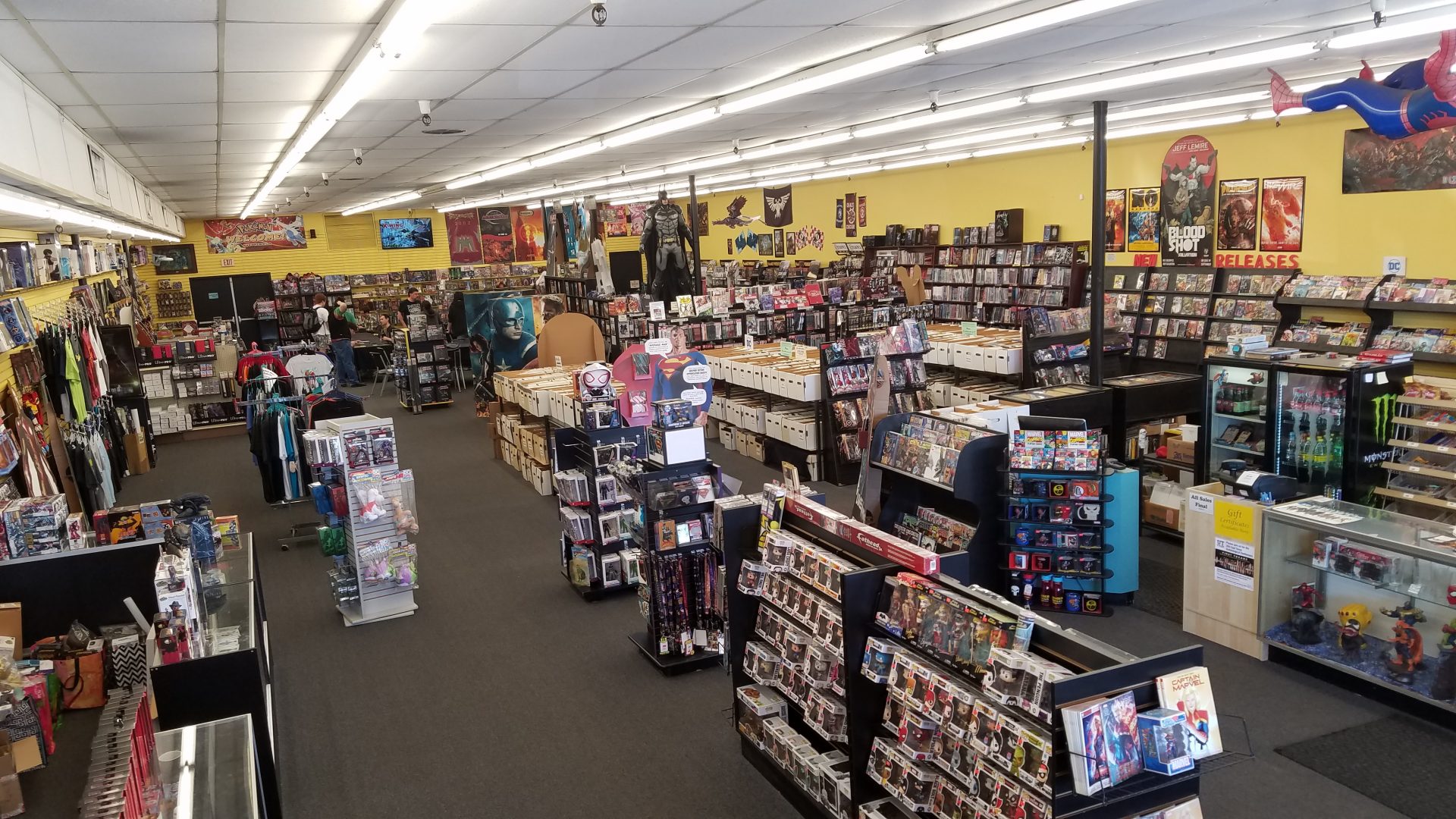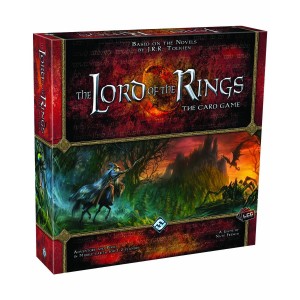 See? I told you my next game review wouldn’t be a Star Trek game. Since my Star Trek: Fleet Captains review went up, the board game community here at Ground Zero has really taken off, and so there’s been a lot of exposure for people to a lot of new games, both in familiar styles, and in new, sometimes daring formats. One of those new formats, and one that I find particularly intriguing, is Fantasy Flight Games’ LCG, or Living Card Game, model.
See? I told you my next game review wouldn’t be a Star Trek game. Since my Star Trek: Fleet Captains review went up, the board game community here at Ground Zero has really taken off, and so there’s been a lot of exposure for people to a lot of new games, both in familiar styles, and in new, sometimes daring formats. One of those new formats, and one that I find particularly intriguing, is Fantasy Flight Games’ LCG, or Living Card Game, model.
Essentially, these games work like a traditional Collectible Card Game in the vein of Magic: the Gathering, Pokemon, or Yu-gi-oh! But instead of sinking a possibly unlimited amount of money into the lottery or gamble-based system of rare cards and booster packs that was popularized by those games, Fantasy Flig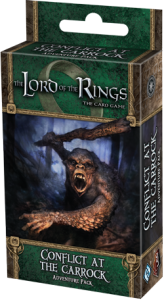 ht has adopted a much more user friendly pricing model. Essentially, for each one of these games (currently, FFG produces 4, with a 5th on the horizon), there is a core set, priced at $40, that contains just that – the entire core set for the game. It functions as a standalone game for two people, but also forms the base upon which individual players will build their collection of cards. They then release monthly “mini-expansions” that cost $15 each, with the occasional “full” expansion, which typically adds an entirely new game mechanic, and is priced at $30 (I believe these are released roughly twice a year). So, essentially, any given player can be assured to get every single card released for any one of these games over the course of a given year, for a total of just over $200. Anyone who’s ever played Magic or similar CCGs knows how much of a change this is from that pricing model.
ht has adopted a much more user friendly pricing model. Essentially, for each one of these games (currently, FFG produces 4, with a 5th on the horizon), there is a core set, priced at $40, that contains just that – the entire core set for the game. It functions as a standalone game for two people, but also forms the base upon which individual players will build their collection of cards. They then release monthly “mini-expansions” that cost $15 each, with the occasional “full” expansion, which typically adds an entirely new game mechanic, and is priced at $30 (I believe these are released roughly twice a year). So, essentially, any given player can be assured to get every single card released for any one of these games over the course of a given year, for a total of just over $200. Anyone who’s ever played Magic or similar CCGs knows how much of a change this is from that pricing model.
Aside from their forward-thinking pricing structure, however, FFG’s Living Card Games function very similarly to your traditional collectible games. Each player builds a deck before play from all the cards they have available, and uses it to try and achieve the game’s win condition – in the particular case of the Lord of the Rings LCG, a cooperative one. Yep, that’s right – cooperative CCG gameplay. How’s that for a refreshing idea? The core set for Lord of the Rings comes with 3 different scenarios to tackle with a little help from your friends, each full expansion comes with two more, and each mini-expansion comes with another one. So, on a monthly basis, you’ll have new quests to test your fine-tuned decks against, new cards to add to those decks, and new ways to combine things together to make for an immensely interesting, and rewarding, experience.
The Lord of the Rings LCG is also unique from the bevy of other LotR and Middle-Earth themed games put on the market over the years, in that, despite its title, it completely ignores the story of Frodo and the Ring. All of the quests in the LCG take place in the 17-year period between Bilbo Baggins’ final birthday party and the point wherein Frodo leaves the Shire. So, in other words, one of the most interesting periods of Middle-Earth history that Tolkien wrote overall very little about.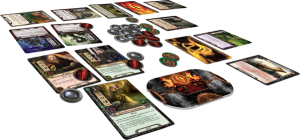
Much of the gameplay in LotR is derived from a variation on tried-and-true combat mechanics that have been around since Magic. Players will choose 1 to 3 (usually 3 in my experience) Hero characters that begin in play for them. These heroes, in addition to questing and participating in combat, provide resources with which players can call forth all manner of aids from their deck, including allies, equipment, events, and other sundries that CCG players should be intimately familiar with. The uniqueness of the gameplay comes from the cooperative aspect. Each scenario has a Shadow Deck which is separate from the player decks, and which contains all the nasties your group will have to overcome. At the start of each turn, all players will commit a certain number of characters to the quest, which means they can’t be used for anything else (like, say, combat) on that turn. You then flip over 1 card from the shadow deck for each player (this is the only way in which the difficulty scales for the number of people playing, and it works reasonably well). If you didn’t commit enough characters to the quest, you’ll take penalties (enough of which will 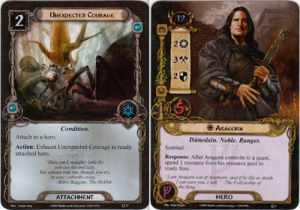 eliminate individual players from the game), but if you get over the target number, you’ll gain progress towards completing the quest, which, along with a victory condition revealed at the end, is the path to winning. However, cards that get revealed from the shadow deck, in addition to providing your target number for the quest, can also jump out and attack you, which is why you never want to commit all of the parties’ resources to the quest.
eliminate individual players from the game), but if you get over the target number, you’ll gain progress towards completing the quest, which, along with a victory condition revealed at the end, is the path to winning. However, cards that get revealed from the shadow deck, in addition to providing your target number for the quest, can also jump out and attack you, which is why you never want to commit all of the parties’ resources to the quest.
Its this balancing act that makes up the majority of gameplay, and let me tell you, it can be tough. I’m used to being able to beat co-op games fairly quickly, if not even on the first try most of the time, and this game beat the crap out of me a few times, even on the easier scenarios. Lord of the Rings games should always be a struggle against overwhelming odds, and this game certainly delivers on that.
I’m not sure I know of a co-operative tabletop game 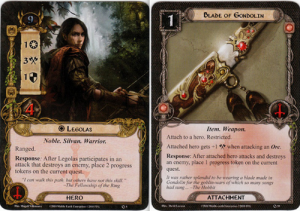 with the near-infinite replayability of the LotR LCG. With All the new quests constantly being released, as well as new cards to keep on fine-tuning your decks, as well as building new ones to handle different situations, I don’t see this one getting old for me any time soon. Its also worth noting that the artwork in this game is nothing short of stunning. FFG really pulled out all the stops to bring Tolkien’s world to life in the most fulfilling way since the Jackson films. In addition, because of the game’s semi-collectible nature, its ripe for some dedicated organized play up at Ground Zero if enough people start playing, which I would love to see happen. Failing that, though, expect this one to show up some at our Friday Night Board Game group, which, if you’re not already attending, you should be.
with the near-infinite replayability of the LotR LCG. With All the new quests constantly being released, as well as new cards to keep on fine-tuning your decks, as well as building new ones to handle different situations, I don’t see this one getting old for me any time soon. Its also worth noting that the artwork in this game is nothing short of stunning. FFG really pulled out all the stops to bring Tolkien’s world to life in the most fulfilling way since the Jackson films. In addition, because of the game’s semi-collectible nature, its ripe for some dedicated organized play up at Ground Zero if enough people start playing, which I would love to see happen. Failing that, though, expect this one to show up some at our Friday Night Board Game group, which, if you’re not already attending, you should be.
One final note: Fair warning, I’ve done my non-Star Trek game review now. Expect my thoughts on the amazingly fantabulous (or was it fantabulously amazing?) Star Trek Deck-Building Game soon.

